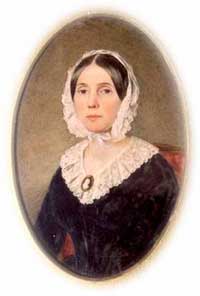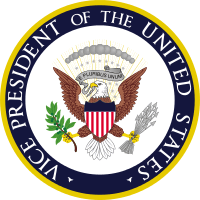Floride Calhoun
| Floride Calhoun | |
|---|---|
 | |
| Second Lady of the United States | |
|
In role March 4, 1825 – December 28, 1832 | |
| President |
John Quincy Adams Andrew Jackson |
| Preceded by | Hannah Tompkins |
| Succeeded by | Letitia Tyler (1841) |
| Personal details | |
| Born |
February 15, 1792 Charleston, South Carolina, U.S. |
| Died |
July 25, 1866 (aged 74) Pendleton, South Carolina, U.S. |
| Spouse(s) | John Calhoun (1811–1850) |
| Children | 10 |
| Religion | Episcopalianism |
Floride Bonneau Calhoun (February 15, 1792 – July 25, 1866) was the wife of prominent U.S. politician John C. Calhoun. She is best known for her leading role in the Petticoat affair, which occurred while her husband was serving as Vice President. During the affair, Mrs. Calhoun led the Cabinet wives in ostracizing Peggy Eaton, the wife of Secretary of War John Eaton, whom they considered a woman of low morals. The affair helped damage relations between John C. Calhoun and President Andrew Jackson, and helped Calhoun's rival, Martin Van Buren, become president.
Background and early life
She was born Floride Bonneau Colhoun to U.S. Senator John E. Colhoun and Floride Bonneau. She was a niece of Rebecca Colhoun Pickens, wife of Andrew Pickens. On January 8, 1811, she married John C. Calhoun, her first-cousin-once-removed (her father's first cousin). Soon after their marriage, her husband was elected to Congress, leaving his wife in charge of his plantation, Fort Hill, in present-day Clemson, South Carolina. Within the next eighteen years, she gave birth to ten children, including five sons and five daughters, although three daughters died in infancy: 1. Andrew Pickens Calhoun (1811–1865); 2. Floride Pure Calhoun (1814–1815); 3. Jane Calhoun (1816–1816); 4. Anna Maria Calhoun (1817–1875); 5. Elizabeth Calhoun (1819–1820); 6. Patrick Calhoun (1821–1858); 7. John Caldwell Calhoun, Jr. (1823–1850); 8. Martha Cornelia Calhoun (1824–1857); 9. James Edward Calhoun (1826–1861); and 10. William Lowndes Calhoun (1829–1858). Her fourth child, Anna Maria, married Thomas Green Clemson, founder of Clemson University in South Carolina.
In 1817, she accompanied her husband to Washington upon his appointment as Secretary of War.
Second Lady
Eight years later in 1825, she became Second Lady of the United States, following her husband's election as Vice President, serving in that role until 1832.
Petticoat affair
During her tenure as Second Lady, she took the lead in a social war against Margaret O'Neill Eaton, the wife of Secretary of War John Eaton, in what became known as the Petticoat affair.
Calhoun had organized a coalition among the wives of Jackson cabinet members against Peggy Eaton, whom Calhoun believed had committed adultery and was acting irresponsibly in Washington. Historian John Marszalek explains why Washington society found Peggy unacceptable:
- She did not know her place; she forthrightly spoke up about anything that came to her mind, even topics of which women were supposed to be ignorant. She thrust herself into the world in a manner inappropriate for woman.... Accept her, and society was in danger of disruption. Accept this uncouth, impure, forward, worldly woman, and the wall of virtue and morality would be breached and society would have no further defenses against the forces of frightening change. Margaret Eaton was not that important in herself; it was what she represented that constituted the threat. Proper women had no choice; they had to prevent her acceptance into society as part of their defense of that society’s morality. [1]
President Jackson was opposed by Vice President Calhoun and most of his own cabinet. The result was the resignation of all but one Cabinet member in 1831. It permanently destroyed friendly relations between Vice President Calhoun and President Jackson, and changed the trajectory of John Calhoun's career.[2]
According to historian David Howe, the revolt against Eaton and the president led by Floride Calhoun influenced the emergence of feminism. The Cabinet wives insisted that the interests and honor of all women were at stake. They believed a responsible woman should never accord a man sexual favors without the assurance that went with marriage. A woman who broke that code was dishonorable and unacceptable. Howe notes that this was the feminist spirit that in the next decade shaped the woman's rights movement. The aristocratic wives of European diplomats in Washington shrugged the matter off; they had their own national interest to uphold.[3]
Return to South Carolina
Following her husband's resignation as Vice President and election to the United States Senate in 1832, Mrs. Calhoun returned to Fort Hill, resuming her former status as a plantation mistress. Her husband died in 1850. In 1854, she sold the plantation to her oldest son, Andrew Pickens Calhoun, and held the mortgage. A year later, she moved to a smaller house in Pendleton, South Carolina, which she dubbed "Mi Casa" in 1855. She endured the deaths of six of her seven surviving children. After Andrew died in 1865, she filed for foreclosure against Andrew's heirs.
Death and protracted estate issues
Floride Calhoun died on July 25, 1866 and was buried in St. Paul's Episcopal Church Cemetery in Pendleton, South Carolina, near her children, but separate from her husband who is buried at St. Philip's Episcopal Church Cemetery in Charleston. The Fort Hill plantation was eventually auctioned at Walhalla in 1872, after lengthy legal proceedings. The executor of her estate won the auction, which was divided among her surviving heirs. Her daughter, Anna Maria Calhoun Clemson and son-in-law, Thomas Green Clemson, received about three-quarters of the plantation, including the house, and her great granddaughter, Floride Isabella Lee, received the balance.[4]
References
- ↑ John F. Marszalek, The Petticoat Affair (2000) pp 56-57
- ↑ Clemson University page on Floride Colhoun Calhoun
- ↑ Daniel Walker Howe, What Hath God Wrought? (2007) pp 337-39
- ↑ E. M. Lander, Jr., The Calhoun Family and Thomas Green Clemson: The Decline of a Southern Patriarchy, University of South Carolina Press, Columbia, SC, 1983.
Further reading
- Bartlett, Irving H. John C. Calhoun: A Biography (1994).
- Lander Jr, Ernest M. "Mrs. John C. Calhoun and the Coming of the Civil War." Civil War History 22#4 (1976): 308-317. online
- Marszalek, John F. The Petticoat Affair: Manners, Mutiny, and Sex in Andrew Jackson's White House (2000).
- Wiltse, Charles M. John C. Calhoun, Nationalist, 1782–1828 (1944); John C. Calhoun, Nullifier, 1829–1839 (1948); John C. Calhoun, Sectionalist, 1840–1850. (1951).
Primary sources
- McGee Jr, Charles M., and Ernest McPherson Lander Jr. A Rebel Came Home: The Diary and Letters of Floride Calhoun 1863–1866 (2nd ed. 1989).
External links
| Honorary titles | ||
|---|---|---|
| Preceded by Hannah Tompkins |
Second Lady of the United States 1825–1832 |
Vacant Title next held by Letitia Tyler |
